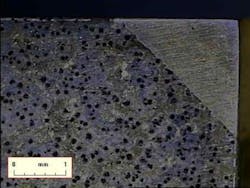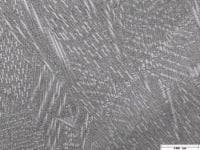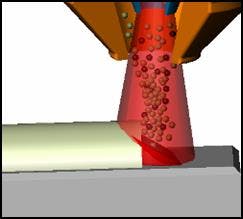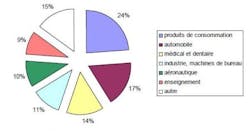Cladding and additive manufacturing by laser metal deposition—the time of industrialization
JEAN-PAUL GAUFILLET, FRÉDÉRIQUE MACHI, DIDIER BOISSELIER, and EMMANUEL LAUBRIAT
The principle of laser deposition consists of fusing a metal filler material and a very thin layer of the surface of the substrate to ensure a metallurgical bond (FIGURE 1). The laser beam is then a vector of a precise and localized heat input.
Material is mainly brought in the form of powder, which offers the advantage of depositing a very wide choice of metal materials.
The powder is injected laterally or coaxially into the laser beam. If the first technique shows great simplicity, it should be noted that a difficult control of the injector position in relation to the direction of travel is necessary to do complex shapes.
This factor explains the major use of coaxial devices that thus allow multidirectional cladding. In addition, since the irradiation of the filling material is slower and more regular than during lateral injection, the evenness of the deposition and the yield of deposition of the whole are higher.
The coaxial nozzle, a widely used industrial tool
For many years, IREPA LASER has developed and patented (no. 5418350 of May 23, 1995) a coaxial nozzle that allows, in addition to industrial use (several tens of installations in the world, some of which do 4000–6000 hrs. of cladding per year), a material yield of 85–100% and excellent gas coverage.
General characteristics of laser deposition
The intrinsic characteristics of laser cladding ensure:
The metallurgical quality of the deposits. The bond of metallurgical type guarantees very low risks of delamination, and the fusion of the filler material makes it possible to obtain a dense deposition.
The characteristics of the deposition depend on the chemical composition of the filler material used. A wide variety of materials may be deposited, like iron bases (carbon steel, stainless steel, tool steel, etc.), cobalt bases (Stellite), nickel bases (Inconel, Hastelloy, etc.), titanium bases, and aluminum alloys, among others.
The speed of the thermal cycle makes it possible to obtain very fine microstructures and higher hardnesses than traditional welding and cladding techniques. In general, these fine structures increase resistance to corrosion. In the case of metal matrix compounds (MMCs), laser cladding avoids the fusing of hard compounds (generally carbides), which remain present in a metal matrix.
It should, however, be noted that this technique of fusion cladding can lead to defects related to stresses, metallurgical incompatibility of materials, or even the compounds formed in the bonding area between deposition and substrate.
A very low dilution. In laser treatment, dilution (namely the participation of the substrate in the deposition) is controllable and low (less than 5% in the case of steel), which allows good conservation of properties of the deposited material. Among other things, this particularity limits the number of layers required for obtaining a particular chemical composition on the surface.
The respect of the geometry. The speed of the thermal cycle and the low heated volume have the effect of limiting the trauma suffered by the part. The heat-affected zone (HAZ) is reduced and the deformations are then lower than with other processes, while the location of the thermal impact also allows work in critical areas in term of thin adjacent walls, edges, etc. The automated process allows a high degree of accuracy of trajectory and low machining times when these are needed.
Laser cladding
With the advantage of the characteristics and peculiarities previously mentioned, laser cladding offers the following possibilities:
- Reducing and/or limiting the amount of filler material and the excess machining thickness while limiting deformations (FIGURE 2);
- Allowing reinforcement in sensitive areas (wall thickness, edge, etc.) because if the thermal impact is inseparable from the process, it is however localized, limited, and easily controllable; and
- Automation of the process avoids the need for human intervention, which is sometimes delicate in terms of accuracy, qualification, reproducibility, and staff availability.
Comparative examples illustrate the peculiarities of laser cladding. The examples of cobalt base deposits (TABLE 1) illustrate the impact of the dilution in terms of reduction of the quantity of the filler metal accompanied by an increase of hardness.
For deposits of grade 6 Stellite, the stability of the hardness between a laser deposition made in one layer and two layers shows that the performance of chemical composition are reached from the first layer (FIGURE 3). For the deposits using the TIG process (FIGURE 4), the contamination of the deposit with iron lowers the hardness significantly. Then, it is necessary to increase the number of layers (therefore, the quantity of matter with the risk of distortion) to reach the objective.
These remarks are also valid on grade 25 Stellite deposits. It should be noted, however, that in this case, the best management of the dilution with the MIG process makes it possible to limit the number of layers.
The speed of the thermal cycle explains the significant difference in the hardness of the deposit (FIGURE 5).
The need to use "hard" coatings is very often associated with the difficulty of machining these coatings.
TABLE 2 shows the irregularity values of the surface for different technologies and thickness of deposit. At this level, the strong point of the laser cladding relies on the automation of the process that ensures a regularity of deposit and dimensions close to the final sizes.
In terms of micrographic structures (FIGURE 6), the images show a dendritic structure that is clearly finer in the case of laser cladding. It should also be noted that the process by fusion gives dense deposits.
Industrial applications are divided between prevention of wear on new parts and repair in varied fields like oil drilling or mining (FIGURE 7), stationery, recycling, energy, agriculture, and mechanics, among others (FIGURE 8).
Cladding solutions are integrated in the companies or subcontracted. With the latter, we should nevertheless note the low number of subcontractors in France.
The laser cladding market is growing exponentially. Standardization of the process allows businesses to integrate the know-how developed by pioneers of the 1990s.
The proven economic gains, brought by the reconditioning of worn parts or by the specification of bi-material parts, justifies investment in the equipment to implement the process.
Yet, this process still remains to this day a matter of specialists who, by the pooling of the needs of their clients, can amortize their machines. It is still rare to see a final user integrate this know-how.
CLAD and additive manufacturing
Conceptually for IREPA LASER, from laser cladding to direct additive laser construction (CLAD), there was only one place. "We said that if we were able to align the beads next to each other, we should also be able to stack them to produce shapes," says Jean-Paul Gaufillet, director of IREPA LASER. Indeed, CLAD (or direct energy deposition [DED]) is a process that allows building metal objects layer by layer directly from a computer-aided design (CAD) digital file.
Belonging to the field of additive manufacturing, this process makes it possible to build an object from a substrate, to add a function to an existing object, or repair damaged shapes (FIGURE 9).
We talk of additive manufacturing in opposition to the traditional so-called "subtractive" techniques, where the parts are shaped in the mass of a material.
According to Terry Wohler of Wohlers Associates (Fort Collins, CO), additive manufacturing is "the use of a process of direct automated manufacture in the manufacture of parts that are directly used as a finished product or as a component."
These processes are very recent, as they actually emerged only from the 1980s via stereolithography. But as early as the 1960s, being able to manufacture an object in three dimensions by adding material germinated in the minds of writers and other inventors, like for example the science fiction writer Arthur C. Clarke, who spoke of a "replicating machine."
CLAD process details
The CLAD process is the fruit of several years of work. At IREPA LASER, the first work was started in the framework of a STREP European project called RAMATI and a CIFRE thesis to manufacture small metal parts using a laser cladding process. Many developments have been made on this occasion, particularly a new, smaller, and more accurate cladding nozzle, and especially a proof of the feasibility of the process with associated process parameters.
The development of this process has not been without difficulty. To arrive at a viable solution, it was necessary to develop three key and indissociable elements:
The nozzle. Unlike the process of laser cladding that now sees the development of nozzles allowing increasingly large deposits, CLAD requires precision that goes by finer deposits, a better quality of settings, and especially perfect control of the geometrical characteristics of the deposits. The CLAD coaxial nozzle developed in this way ensures the injection of metal powder to melt them with a high yield, favoring multidirectional deposit while guaranteeing an optimal gaseous coverage (FIGURE 10).
The different references of the CLAD coaxial nozzle make it possible to make beads to well-defined dimensions ranging from 0.8mm in width up to more than 4.5mm. The accuracy of the deposit is about one tenth of a millimeter.
The machine. Unlike laser cladding, CLAD is not mounted on robots. It requires the use of a three- or five-axis machine with high mechanical performance to have the required travel accuracy for observing strategies of construction. A powder distributor doses the powder, which is transported by gas to the nozzle. This feeding system can be equipped with several tanks of powder, offering the possibility to inject different natures of powder and create gradients of materials (FIGURE 11).
In the field of metal manufacturing, other manufacturing processes are generally based on the principle of the bed of powder. CLAD technology is based on a nozzle, making the following new applications possible:
- Manufacturing parts of large dimensions (up to 800 × 800 × 1500mm);
- Addition of new features on existing parts (work on left surfaces);
- Repair of consumable parts;
- Matter gradient (progressive mixing of different and/or compatible materials); and
- Great flexibility for the change of material.
The PowerCLAD software. The software has been developed in collaboration with the company DELCAM (editor of the software solution of CAD/CAM) on the basis of a specification defined by IREPA LASER.
It makes it possible to translate the information contained in a digital model from CAD software directly into an ISO program interpreted by the machine and controlling the movements of the head following the calculated trajectories. This unique software on the market, currently in a version 4, incorporates all the strategies of construction specific to the CLAD process. It embarks the different post-processors adapted to controlled machines (FIGURE 12).
Interests of the CLAD process
The properties of the machines and the intrinsic characteristics of the CLAD process provide many advantages in relation to other additive manufacturing technologies. In the field of metal manufacturing, other manufacturing processes are generally based on the principle of the bed of powder (SLM, EBM). CLAD technology, based on a nozzle, makes new applications possible:
- High manufacturing speed (when compared with the so-called processes of fusion on bed of powder) that can reach 100–200cm3/h.
- Possible manufacture of large-dimension parts, limited only by the capacities of the machine. Among these parts, it is necessary to distinguish:
- The so-called functional parts, which will require no or little finishing; and
- The drafts, which are simplified parts close to the actual sizes, but with bigger over-thicknesses. These pre-shapes, which are then machined, make it possible to reduce the quantity of shavings and machining time significantly. In addition, this method avoids the supply of costly blocks of material, which are often not available.
- Addition of new features on existing parts (work on left surfaces). Examples include creation of ribs, bosses on the housings, etc.
- Repair of damaged or worn parts. This is the case of parts of aircraft engines, for example, but this may also be the case of parts of high added value that were scrapped during the machining.
- Multi-materials (multi-layer) or gradient of materials (gradual mixing of different materials to obtain gradients of properties).
- Great flexibility for the change in material and wide choice of materials available on the market.
With more than 10 years of development and the manufacture of five machines, the CLAD process has now reached a level of development that enables it to respond to the needs of industry.
The creation of the BeAM spinoff in 2012 specializes in the manufacture of CLAD machines and the provision of controlled solutions, thanks to the technical support of the transfer center and the qualified repairs of more than 700 critical parts of aircraft engines, which are proof of the industrial maturity reached by technology.
FUI FALAFEL program: Very encouraging results
In October 2014, the FUI FALAFEL program, which was was cofinanced by BPI, the FEDER, and the Alsace region, closed. With an initial duration of four years, the purpose of FALAFEL was manufacturing metal parts by powder-based "additive" processes (SLM, CLAD) for the aeronautical industry (FIGURE 13).
The partners are industrialists of the Aeronautics and Space Industries (GIFAS), DASSAULT, EADS, SNECMA, AIRBUS Helicopter, MBDA, two SMEs, ARES and TPSH, laboratories of the School of Mines, Arts et Métiers, the ENISE, and the UTBM groups for an overall amount of the project of €7 million.
The results of the program have thus demonstrated that it was possible to associate the two SLM and CLAD processes to make the same part.
IREPA LASER has already initiated a new European R & D programme (FP7), the factory of the future, of €23 million with 28 partners and for five years. The objective is to hoist additive manufacturing to a widened industrial level.
A large part of the developments now address the aeronautics sector. This choice is mainly linked to three determining factors—parts with high added value, small series, and high-cost materials.
Outside aeronautics, the process is of interest to other business sectors, where at least one of the previous components is found. It is the case of biomedical applications.
IREPA LASER has thus achieved developments to test the manufacture of implants to fill holes located in the roof of the mouth. This project, conducted in the framework of a call for projects of the Carnot MICA Institute, brought together the skills of several laboratories: INSA/ICS Strasbourg, dental faculty Strasbourg, IS2M in Mulhouse, and AERIAL. It made it possible to:
- Implement the digital chain from the files from a medical scanner up to the custom design of the implant;
- Assess the material obtained using the CLAD process (TA6V grade 23) and the preparation of the surfaces from a biocompatibility point of view;
- Validate the techniques of sterilization of the parts obtained; and
- Make test parts to validate the concept.
Three industrial machines are now fitted in the CLAD platform at IREPA LASER in Alsace, and make up the first group of additive manufacturing machines by material deposition in Europe open to SMEs for R&D and training on the CLAD process, according to Jean-Paul Gaufillet, director of IREPA LASER.
BeAM additive manufacturing machines based on CLAD
"We have a standard range with catalog options—for example, a controlled atmosphere cabin to prevent oxidation if we are working with the a material sensitive to oxidation like titanium and its alloys. But beyond these standard options, we are able to do specific options, or even specific developments, since we control the whole CLAD additive manufacturing process chain, which comprises the software, the process, and the machine," explains Emmanuel Laubriat, chairman of BeAM.
BeAM offers access to new modes of manufacture and repairs. The additive manufacturing processes are not standardized to this day—even if groups are working on the creation of standards or the production of charts, service providers who use this technology must be able to offer their clients an accompaniment to the development of their process. It is by this "solution-oriented" approach that the manufacturer limits risks of its clients in their industrialization of the CLAD process (FIGURE 14). This offer also ensures that customers get a quick return on their investment.
In the face of the novelty of the processes, the different steps of the support offer have been designed to accompany the industrialists, regardless of their level of development:
- Feasibility studies, pilot production, sales of systems; and training; and
- Recognized experience in aeronautics.
Repair of critical parts of aircraft engines
In collaboration with the company Chromalloy, the CLAD process has been developed and qualified for the repair of parts of Pratt & Whitney aeronautical turbines by IREPA LASER. These highly critical parts, because they turn at more than 30,000 rpm, prove that with a collaboration of know-how, it is now possible to seize the opportunities of innovation that this process offers.
To date, five types of parts have been repaired and qualified in the catalog of an engine manufacturer, and more than 700 rotating parts have been repaired and are returned to flight.
Conclusion
If we look at the path traveled by these innovative processes, a few important milestones need to be emphasized:
- Laser cladding was identified very quickly as a promising process in 1974—since then, laboratories have been conducting research. The work of these first pioneers made it possible to understand phenomena, to develop tools, and analyze the fields of applications.
- Laser technologies have, on their side, known many developments in terms of diversity, power levels, reliability, and cost of investment.
- All these developments have not hampered the academic research, the material suppliers' developments, or the technical centers present on all the continents with industrial applications in all sectors.
- The development of industrial activities around additive manufacturing technologies whet the appetites of States to get themselves recognized as leaders in these fields. Each one now recognizes a possibility of relocating jobs in the rich countries and a "revolution" equivalent to that of the arrival of the Internet. These innovative processes each allow innovating both at the level of new parts that can be produced (shapes, materials), of new industrial processes (e.g., repair), and services (small productions that can be produced by all and each one).
- While the policy of American concentration is already felt by the buying of French companies and the hegemony of German industry is boosted by their collaborative approach (industry, research center, public funds), we should be attentive not to miss this revolutionary niche, whereas strong French skills are available to ensure the development and industrialization of these new opportunities.
ACKNOWLEDGEMENT
CLAD is a registered trademark of IREPA LASER.
JEAN-PAUL GAUFILLET, FRÉDÉRIQUE MACHI, and DIDIER BOISSELIERare with IREPA LASER, Illkirch-Graffenstaden, France (www.irepa-laser.com/en), andEMMANUEL LAUBRIATis with BeAM, Illkirch-Graffenstaden, France (www.beam-machines.fr).
Additive manufacturing: third industrial revolution?
A study submitted on March 15, 2012 by the Ministry of the Economy, Finance and Industry (with the support of 250 experts) on key manufacturing techniques identified additive manufacturing among 85 other innovative technologies.
Indeed, additive manufacturing is regularly compared to inventions that have revolutionized economies like computers or printing in their time. Additive manufacturing calls some of the foundations of the industrial economy as we know it into question.
Investments and limited financial risks
This type of installation offers a rupture in the traditional process of industrial production of objects. The investments generated by the completion of a prototype or a directly functional part are significantly reduced. These systems make it possible to skip over means of pressing, machining, forging, casting, and assembling, among others, and no longer make series production indispensable. This allows professionals to perform more tests and the objects thus produced are more qualitative.
Mass customization
Using a computer model as the basis of making products makes it possible to integrate differences between each part, and for a marginal cost. It is "mass customized" production, which enables response to a growing current need for individualized products, and offers real flexibility and a competitive advantage for businesses using this type of process.
Let us also note that with this type of machine, relocations would lose all their advantage, which would bring a highly positive economic consequence in heavily developed countries like France. Additive manufacturing thus departs very strongly from the principles of economies of scales and large series that lie at the basis of the industrial system.
A dramatic acceleration
In the space of only 15 years, sales of additive manufacturing systems in industry have been multiplied by 10. The global market for 3D printing alone amounted to $2.2 billion with an annual growth of almost 30%.
Many countries are committed to the additive manufacturing race. In February 2012, Barack Obama—in his State of the Union Address—called on the United States to participate "in the next production revolution." $1 billion has been allocated to develop these technologies.
Other countries like China, Japan, or Germany have strongly invested in these processes. To illustrate this, we can see the distribution of 3D printers and associated services in the world.
A strong potential market: Additive manufacturing as a source of innovation and industrial applications
The processes of additive manufacturing offer wide technical possibilities, reveal themselves as sources of innovations, and its market is wide and promising in terms of industrial opportunities.
A variety of applications
- In the United States, the army has developed "micro mobile plants" equipped with additive manufacturing technologies. The purpose of these transportable factories is to be able to manufacture necessary parts or repair them directly in place.
- In the medical field, we can mention the example of the startup Organovo, which prints human tissues from living cells.
- Also in the medical field, ears (cartilage) or skin are already "printed." Many programs are working on the production of custom-made prostheses.
- In civil engineering, several "printer" prototypes are being developed to manufacture homes—the walls of a house could be printed in 20 hours!
Many other applications are being developed and only the imagination seems to limit additive manufacturing processes.
There are many opportunities that will bring many changes in all fields. The first countries and industrialists to invest in these technologies will benefit from an advance in this very promising market.






















